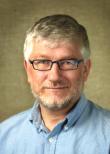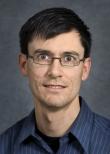Staff
Milica Grahovac works with the Energy Efficiency Standards Department at the Energy Technologies Area.
Milica performs and leads modeling, research, and analysis at the intersections of energy conservation standards, policy, economics, energy efficiency, renewable energy systems, controls, and energy flexibility.
She combines her skills to develop generalized analytical methods and software tools targeting research, education, policy, and industrial audiences.
Philip Haves is the retired Leader of the Simulation Research Group. He has worked on different aspects of commercial buildings since 1986, with particular interests in simulation and in building operations. He is a Fellow of ASHRAE, the chair of its Technical Committee on Energy Calculations and a former Chair of its Technical Committee on Building Operation Dynamics. He is the immediate past president of IBPSA-USA, the US affiliate of the International Building Performance Simulation Association. He has a BA in Physics from Oxford University and a PhD in Radio Astronomy from Manchester University.
Dr. Tianzhen Hong is a Senior Scientist leading research on technologies, data, methods, computing, occupant behavior, and policy for design and operation of low energy buildings and sustainable urban systems. He is leading the EnergyPlus development at LBNL. He established and chairs the ASHRAE Technical Committee 7.10 Occupant behavior in building design and operation. He actively contributed to international collaborations such as the 10-year U.S.-China Clean Energy Research Center on Building Energy Efficiency, IEA EBC Annex 53, 66, 79, and 81. He was co-Operating Agent of Annex 66 and co-lead of Subtask 3 of Annex 79. He led the development of two building energy software: CBES and CityBES winning an R&D 100 Award in 2019 and 2022, respectively. He is an IBPSA Fellow, an ASHRAE Fellow, and a Highly Cited Researcher since 2021. He received B.Eng. and Ph.D. in HVACR, and B.Sc. in Applied Mathematics from Tsinghua University, China.
Links
Urban Systems Research
Urban Systems Group, UrbanSystems.lbl.gov
City Buildings, Energy, and Sustainability (CityBES), CityBES.lbl.gov
Occupant Behavior Research
LBNL, behavior.lbl.gov
Occupancy Simulator, occupancysimulator.lbl.gov
IEA EBC Annex 79 (2018-2023): Occupant-centric building design and operation
IEA EBC Annex 66 (2013-2018): Definition and simulation of occupant behavior in buildings
IEA EBC Annex 53 (2008-2013): Total Energy Use in Buildings: Analysis & Evaluation Methods
ASHRAE Technical Committee 7.10 Occupant Behavior in Building Design and Operation
Building Energy Modeling and Analysis Tools
Commercial Building Energy Saver: California version, cbes.lbl.gov; National version, cbespro.lbl.gov
EnergyPlus, energyplus.net
Publications
https://scholar.google.com/citations?user=x5m2zBYAAAAJ&hl=en
Jianjun Hu is Eng/Env Technology Researcher III in Simulation Research Group of Building Technology and Urban Systems Division. His major focus is the development of open platform tool for designing building control and system commissioning. He is also playing major role on developing next generation of EnergyPlus. Before joining LBNL in Feb., 2017, Jianjun was a Senior Research Engineer in United Technologies Research Center (China), in where, he acted as principal investigator of projects associated with super tall building airflow management, like stack effect mitigation, smoke control and wind effects on HVAC system. At there, he also worked on developing virtual building test bed on Dymola platform.
Jianjun received PhD degree in Civil Engineering from Purdue University in August 2014. His PhD research focused on applying model predictive control strategies on buildings with mixed-mode cooling, to minimize HVAC energy usage while ensuring occupant thermal comfort through dynamic modeling and strategy optimization. Prior to the PhD program, he was a two-years visiting researcher in School of Mechanical Engineering of Purdue, and investigated the algorithms for fast fluid dynamic simulation in building. He received master and bachelor degree from University of South China in 2006 and 2003 respectively.
Jianjun is associate member of the American Society of Heating, Refrigerating, and Air-conditioning Engineers (ASHRAE). He is also member of International Building Performance Simulation Association – USA (IBPSA-USA).
Jared Langevin is a Research Scientist at Lawrence Berkeley National Laboratory, where he models the national impacts of building efficiency on long-term energy use and CO2 emissions, develops decision support algorithms for energy flexible building operations, and researches human-building interactions. Based in Washington, D.C., Jared was previously a Science and Technology Policy Fellow at the U.S. Department of Energy’s Building Technologies Office (BTO), where he co-created BTO’s Scout program for national building efficiency impact analysis. Jared holds a Ph.D. in Architectural Engineering from Drexel University, where his research focused on measuring and modeling the adaptive interactions between building occupants and their surrounding thermal environments, examining the links between these interactions and building energy use. Before entering into his graduate studies at Drexel, Jared received a Bachelor’s degree in Architecture from Carnegie Mellon University.
Sang Hoon Lee is a senior scientific engineering associate in the Building Technology and Urban Systems Division. He received a Ph.D. in Building Technology and M.S. in Integrated Facility Management from the Georgia Institute of Technology. He is a LEED accredited professional with USGBC and a Facility Management Professional with IFMA. His current work focuses on the building energy simulation and modeling method in different fidelities and for diverse needs. Prior to joining LBNL, he worked at the Georgia Institute of Technology for developing energy modeling methods that are implemented in tools such as Energy Performance Standard Calculation Toolkit for easy use by building owners, architects, and engineers and Network Energy Performance Toolkit for campus-scale energy evaluation.
Kaiyu Sun is a Research Scientist in the Building Technology and Urban Systems Division at Lawrence Berkeley National Laboratory. Her research mainly focuses on energy modeling with EnergyPlus and OpenStudio, development of energy modeling tools (e.g., OpenStudio, Commercial Building Energy Saver), automatic model calibration, occupant behavior modeling, and building thermal resilience.
Michael Wetter is a Staff Scientist at the Simulation Research Group at Lawrence Berkeley National Laboratory (LBNL). His research includes integrating building performance simulation tools into the research process, as well as their use for design and operation. He is leading the development of Spawn of EnergyPlus, a next-generation simulation engine for building and district energy and control systems, OpenBuildingControl, a project that digitizes the control delivery process, and the Modelica Buildings Library, the largest Modelica library for building energy and control systems. He has also been developing the Building Controls Virtual Test Bed software for co-simulation and model-based operation, co-simulation tools based on the Functional Mockup Interface standard and the GenOpt optimization program. He is the co-operating agent of IBPSA Project 1 and was co-operating agent of IEA EBC Annex 60, two multinational collaborations that develop new generation computational tools for buildings and community energy systems between 2013 and 2022. Prior to joining LBNL, he led the development of building system models at the United Technologies Research Center (UTRC). He did his dissertation at the University of California at Berkeley and at LBNL, where he created the GenOpt optimization program and the BuildOpt building simulation program and where he developed the first building energy optimization technique that provably converges to the optimal building design. He is a recipient of the bi-annual Outstanding Young Contributor Award of IBPSA and of the bi-annual Distinguished Achievements in Building Simulation Award of IBPSA-USA. He is the Chair of the College of Fellows of IBPSA, an IBPSA Fellow, and a member of the Boards of IBPSA and the Modelica North America Users’ Group. He was Treasurer of IBPSA and President of IBPSA-USA.













